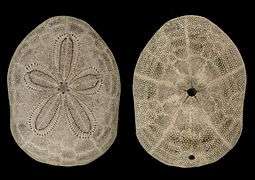Clypeaster
| Clypeaster Temporal range: Late Eocene - Recent | |
|---|---|
| | |
| Clypeaster sp. from Early Miocene, in Vibo Valentia, Italy | |
| Scientific classification | |
| Kingdom: | Animalia |
| Phylum: | Echinodermata |
| Subphylum: | Eleutherozoa |
| Superclass: | Cryptosyringida |
| Class: | Echinoidea |
| Subclass: | Euechinoidea |
| Superorder: | Gnathostomata |
| Order: | Clypeasteroida |
| Suborder: | Clypeasterina |
| Family: | Clypeasteridae |
| Genus: | Clypeaster Lamarck, 1801 |
Clypeaster, common name "cake urchins" or "sea biscuits", is a genus of echinoderms belonging to the family Clypeasteridae.
Etymology
The genus name Clypeaster is derived from the Latin “clypeus” (meaning round shield) and “aster” (meaning star), with reference to the shape of these organisms.
Description
Genus Clypeaster includes irregular sea urchins with a bilateral symmetry (Bilateria). They have a rounded pentagonal outline. The anus of these large burrowing cake urchins has migrated from the apical disc to the oral side, on the lower surface. Besides this development, the mouth has moved in the center of the base and the body has flattened. These changes accompany a change in lifestyle, as by day they live partially or completely buried in sand in shallow waters and emerge at night to feed on the sediment.
Distribution
This genus has a worldwide distribution. Fossils can be found from late Eocene (33.9–37.2 mya) to Recent age.
Habitat
Clypesater is a typical form of shallow waters of tropical areas.
List of Species[1]
- Clypeaster aloysioi (Brito, 1959)
- Clypeaster amplificatus Koehler, 1922
- Clypeaster annandalei Koehler, 1922
- Clypeaster australasiae (Gray, 1851)
- Clypeaster chesheri Serafy, 1970
- Clypeaster cyclopilus H.L. Clark, 1941
- Clypeaster durandi (Cherbonnier, 1959b)
- Clypeaster elongatus H.L. Clark, 1948
- Clypeaster euclastus H.L. Clark, 1941
- Clypeaster europacificus H.L. Clark, 1914
- Clypeaster eurychorius H.L. Clark, 1924
- Clypeaster euryptealus H.L. Clark, 1925
- Clypeaster fervens Koehler, 1922
- Clypeaster humilis (Leske, 1778)
- Clypeaster isolatus Serafy, 1971
- Clypeaster japonicus Döderlein, 1885
- Clypeaster kieri Pawson & Phelan, 1979
- Clypeaster lamprus H.L. Clark, 1914
- Clypeaster latissimus (Lamarck, 1816)
- Clypeaster leptostracon A. Agassiz & H.L. Clark, 1907
- Clypeaster luetkeni Mortensen, 1948
- Clypeaster lytopetalus A. Agassiz & H.L. Clark, 1907
- Clypeaster microstomus Lambert, 1912 †
- Clypeaster miniaceus H.L. Clark, 1925
- Clypeaster minihagali Deraniyagala, 1956 †
- Clypeaster nummus Mortensen, 1948
- Clypeaster ochrus H.L. Clark, 1914
- Clypeaster ohshimensis Ikeda, 1935
- Clypeaster oliveirai Krau, 1952
- Clypeaster pallidus H.L. Clark, 1914
- Clypeaster pateriformis Mortensen, 1948
- Clypeaster prostratus (Ravenel, 1845)
- Clypeaster rangianus Desmoulins, 1835
- Clypeaster rarispinus de Meijere, 1903
- Clypeaster ravenelii (A. Agassiz, 1869)
- Clypeaster reticulatus (Linnaeus, 1758)
- Clypeaster rosaceus (Linnaeus, 1758)
- Clypeaster rotundus (A. Agassiz, 1863)
- Clypeaster speciosus Verrill, 1870
- Clypeaster subdepressus (Gray, 1825)
- Clypeaster telurus H.L. Clark, 1914
- Clypeaster tumidus (Tension-Woods, 1878)
- Clypeaster virescens Döderlein, 1885
Gallery
-

Clypeaster reticulatus
-

Fossil of Clypeaster bowersi the San Diego Natural History Museum, California
-

Fossil of Clypeaster insignis at the San Diego County Fair, California
-

Fossil of Clypeaster portentosus at the Museo Arqueológico Municipal de Cartagena
-
_derivate_2013.jpg)
Clypeaster rosaceus (aboral and internal views), by Ernst Haeckel in Kunstformen der Natur (1904).
References
- Clypeaster Lamarck, 1801
- Animal Diversity
- NCNI
- National History Museum
- Sepkoski, Jack Sepkoski's Online Genus Database
- Paleobiology Database